





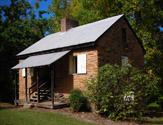









Magnolia Eden
Passion for Butterflies
Passiflora incarnata, or Passion Flower, is a most intriguing plant, worthy of a place in any southern garden where its beauty and function can be fully appreciated. Not particularly fussy and demanding, the plant tolerates a variety of soil conditions and can thrive in full sun and partial shade. Its elaborate, showy flowers falsely allude to more exotic origins, but this American native is widespread throughout the American South and elsewhere. As if its good looks are not enough, Passion Flower is also a host plant to the beautiful Gulf Fritillary butterfly, making it of particular interest to butterfly enthusiasts.
Utilized by Native Americans and grown by southern settlers, Passiflora incarnata was introduced in England in 1629 and first offered in an American nursery/seed catalogue in 1811 by the Philadelphia-based Landreth Nursery.
A vigorous grower, the perennial Passiflora climbs by tendrils, reaching ten-twenty feet. It can also be grown as a ground cover. Blooming between May and September, Passion Flower produces edible oval fruits old-timers often refer to as maypops. Many a southern kitchen has turned out jars of maypop jelly, and some commercial fruit juices available today contain extract from maypops.
While seeds can be retained from the fruits of Passiflora, it is easily propagated by rooting cuttings.
What's in a name?
Named by Roman Catholic missionaries, according to legend, Passiflora is perhaps best known for its Christian symbolism. Hardly referencing eroticism or sexuality, Passion Flower and its various parts represent Christ's crucifixion. There are ten petals for the ten apostles present at the crucifixion, an ovary column resembling a cross, three stigmas for the nails, colored filaments for the crown of thorns, five pollen-bearing anthers for Christ's wounds and coiling vine tendrils reminiscent of whips or scourges.
A Gracious Southern Host
Passiflora incarnata is especially admired by butterfly lovers because it is a host plant to the Gulf Fritillary (Agraulis vanillae). Planted in sufficient quantity along with butterfly-attracting plants like Echinacea, Buddleja and Lantana, southern gardeners are almost guaranteed to witness nature at work as Gulf Fritillaries are drawn to the garden to lay their eggs on the various parts of Passiflora. The resulting spiny larvae feed ravenously on the leaves before pupating and emerging as a new generation of butterflies. With a wingspan of nearly three inches, the Gulf Fritillary is neither a true fritillary nor a heliconian, but rather is classified as a longwing butterfly. Ranging from New Jersey and Iowa to South America, Gulf Fritillaries are very common throughout the American South.
Where is your passion?
Passion Flower can still be found growing on old homesteads, and seeds and cuttings for rooting are often available free for the asking. Seeds are also available commercially and via heirloom seed exchanges. As catalogues begin arriving in the mail later this fall and winter, be sure to add Passiflora incarnata to your seed order. Neither you nor the butterflies will be disappointed!
Utilized by Native Americans and grown by southern settlers, Passiflora incarnata was introduced in England in 1629 and first offered in an American nursery/seed catalogue in 1811 by the Philadelphia-based Landreth Nursery.
A vigorous grower, the perennial Passiflora climbs by tendrils, reaching ten-twenty feet. It can also be grown as a ground cover. Blooming between May and September, Passion Flower produces edible oval fruits old-timers often refer to as maypops. Many a southern kitchen has turned out jars of maypop jelly, and some commercial fruit juices available today contain extract from maypops.
While seeds can be retained from the fruits of Passiflora, it is easily propagated by rooting cuttings.
What's in a name?
Named by Roman Catholic missionaries, according to legend, Passiflora is perhaps best known for its Christian symbolism. Hardly referencing eroticism or sexuality, Passion Flower and its various parts represent Christ's crucifixion. There are ten petals for the ten apostles present at the crucifixion, an ovary column resembling a cross, three stigmas for the nails, colored filaments for the crown of thorns, five pollen-bearing anthers for Christ's wounds and coiling vine tendrils reminiscent of whips or scourges.
A Gracious Southern Host
Passiflora incarnata is especially admired by butterfly lovers because it is a host plant to the Gulf Fritillary (Agraulis vanillae). Planted in sufficient quantity along with butterfly-attracting plants like Echinacea, Buddleja and Lantana, southern gardeners are almost guaranteed to witness nature at work as Gulf Fritillaries are drawn to the garden to lay their eggs on the various parts of Passiflora. The resulting spiny larvae feed ravenously on the leaves before pupating and emerging as a new generation of butterflies. With a wingspan of nearly three inches, the Gulf Fritillary is neither a true fritillary nor a heliconian, but rather is classified as a longwing butterfly. Ranging from New Jersey and Iowa to South America, Gulf Fritillaries are very common throughout the American South.
Where is your passion?
Passion Flower can still be found growing on old homesteads, and seeds and cuttings for rooting are often available free for the asking. Seeds are also available commercially and via heirloom seed exchanges. As catalogues begin arriving in the mail later this fall and winter, be sure to add Passiflora incarnata to your seed order. Neither you nor the butterflies will be disappointed!
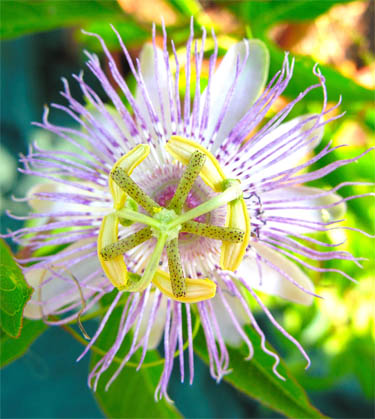
Ed Harshaw
This intricate Passiflora incarnata bloom was photographed on June 27, 2006 in the garden of Southern Edition editor Greg Freeman by Lowcountry photographer Ed Harshaw. Harshaw's work was featured in the story, Ed Harshaw: Capturing the Splendor of the Lowcountry One Photo at a Time.
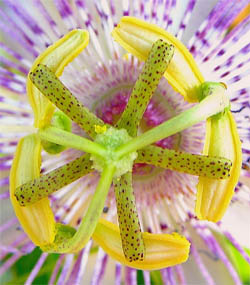
Ed Harshaw
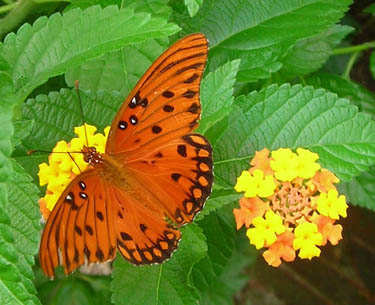
A Gulf Fritillary butterfly paying a visit to Lantana 'Miss Huff'
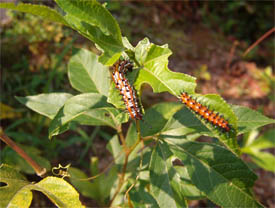
Larvae of the Gulf Fritillary butterfly feeding on the leaves of Passiflora incarnata
BIBLIOGRAPHY
James R. Cothran, Gardens and Historic Plants of the Antebellum South (Columbia: University of South Carolina Press, 2003).
Alice Lounsberry and Mrs. Ellis Rowan, A Guide to the Wild Flowers (New York: Frederick A. Stokes Company, 1899).
Jan W. Midgley, All About South Carolina Wildflowers (Raleigh: Sweetwater Press, Inc., 1999).
Robert T. Mitchell and Herbert S. Zim, Butterflies and Moths: A Guide to the More Common American Species (New York: Golden Press, 1964).
James R. Cothran, Gardens and Historic Plants of the Antebellum South (Columbia: University of South Carolina Press, 2003).
Alice Lounsberry and Mrs. Ellis Rowan, A Guide to the Wild Flowers (New York: Frederick A. Stokes Company, 1899).
Jan W. Midgley, All About South Carolina Wildflowers (Raleigh: Sweetwater Press, Inc., 1999).
Robert T. Mitchell and Herbert S. Zim, Butterflies and Moths: A Guide to the More Common American Species (New York: Golden Press, 1964).
Author: Greg Freeman. Published July 25, 2008.
Copyright
Southern Edition
All Rights Reserved
Southern Edition
All Rights Reserved
All materials contained on this site, including text and images, are protected by copyright laws and may not be reproduced without prior written permission from the publisher. Where applicable, use of some items contained on this site may require permission from other copyright owners.
Fair Use of text from SouthernEdition.com is permitted to the extent allowed by copyright law. Proper citation is requested. Please use this guide when citing a Southern Edition article.
Contact Greg Freeman or SouthernEdition.comFair Use of text from SouthernEdition.com is permitted to the extent allowed by copyright law. Proper citation is requested. Please use this guide when citing a Southern Edition article.